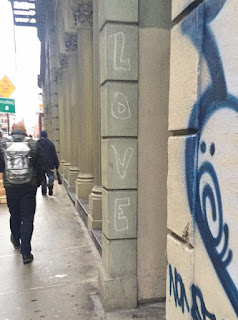In the booming
Soho neighborhood of downtown Manhattan are the four letters “L O V E” written
vertically down the side of a wall on Greene Street. I have taken this route to
work over the past year and a half and this small piece of art has been a
constant in my commute. There are many other pieces of graffiti I have seen
come and go or have been painted over, but this one remains still.
This word written on a wall had not
seemed like a significant piece of work since I first saw it due to the, what I
believe, overuse of it in every day life. I felt like it had a bit of a
cliché meaning to it such as when a pageant contestant answers “world peace” to
the question of what she wishes for the world. This then had me questioning the
intention of the artist. Maybe they simply just believe more love is needed
within our society and wanted to remind people of the love they should
distribute more of into the world. Or perhaps it was in relation to a religious
view of their own.
Art related to religion would be expected
to be a large mural of Jesus or even a small illustration of a cross, but
focusing in on the many concepts religion possesses, the simple word “love”
could also very well be related. Love is constantly mentioned throughout the
Bible with a direct address to love as follows: “So now faith, hope, and love
abide, these three; but the greatest of these is love” (1 Corinthians 13:13).
There are many other examples the Bible holds in relation to helping guide
people to love their enemies, love their neighbors, and most importantly love
God.
American theologian Reinhold
Niebuhr also relates his concept of religion to love. Niebuhr identifies the
purest religion as love that involves being unselfish and is a permanent
contribution to a moral life. He does not preach that love will ultimately make
a moral man, but rather directs to the importance of dualism between love and
coercion to work toward a perfect justice. He concludes his argument by saying,
”To some degree the conflict between the purest individual morality and an
adequate political policy must therefore remain.”
A
part of Buddhism is to practice loving-kindness and compassion that could lead
a lost or suffering person to peace. Many theories within religion relate back
to the concept of love. Maybe we ignore this significant relation because love
is a part of human nature and it is something to be expected and rather foolish
to have to tell somebody to love. However, it being expected could cause for a
greater reason to help remind society of love as this artist does. Maybe the
artist is calling upon the public to question love and where it derives from
and how it relates to our everyday lives. Maybe he/she is asking us to remember
the importance of love in the religion that keeps us going each day.
The
intention of the artist may never be discovered, but this small piece of work
is a great example of life’s every day reminders to reflect upon the concepts
that lead back to the origins of our every day beliefs.

No comments:
Post a Comment